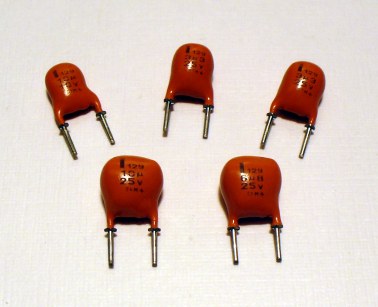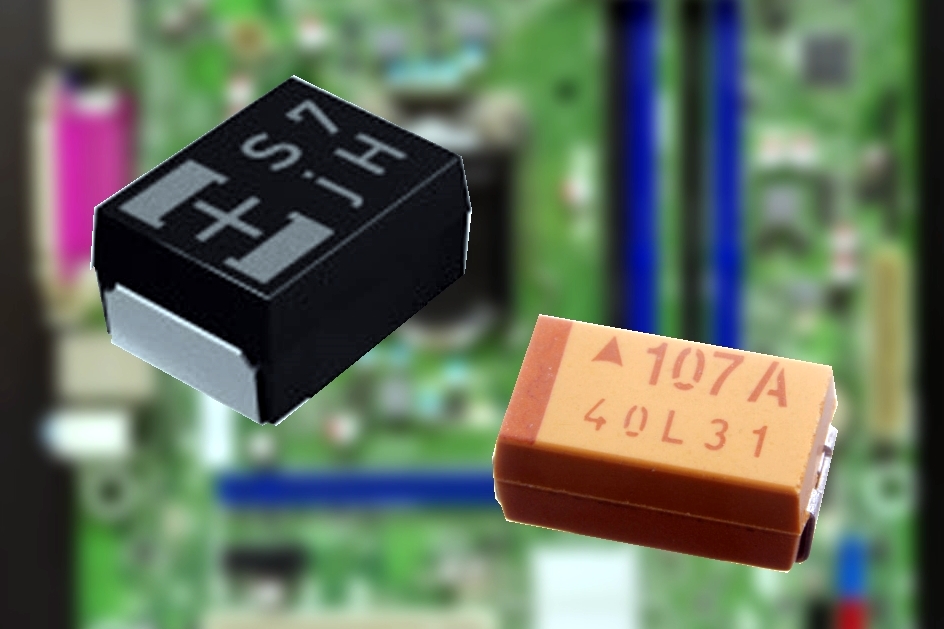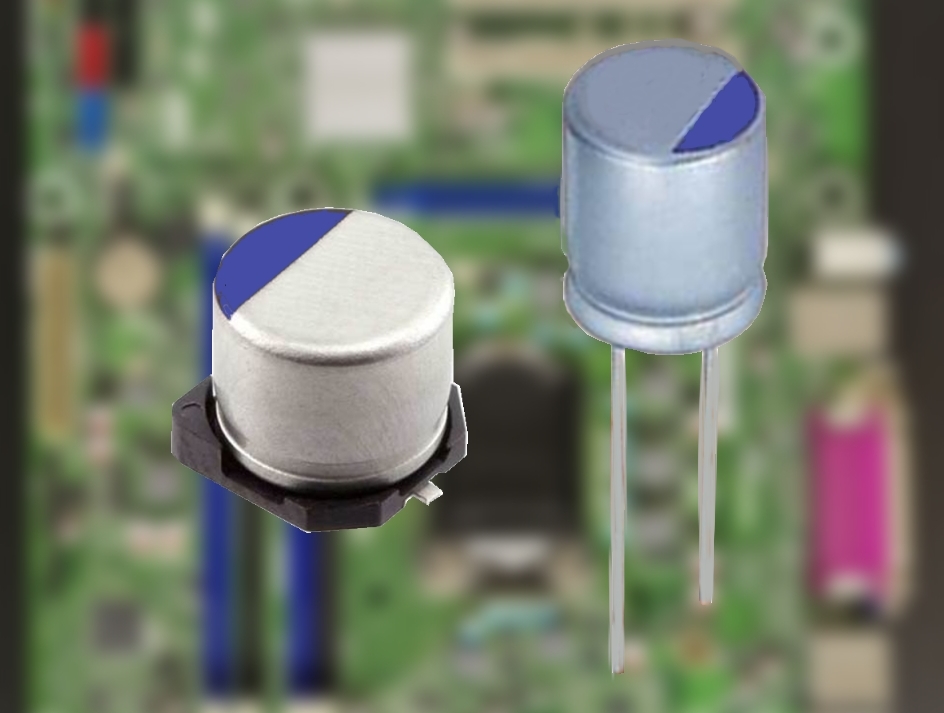|
SAL Electrolytic Capacitor
SAL electrolytic capacitors (SAL meaning ''solid aluminum'') are a form of capacitor developed for high capacitance in a small package, with a long and robust service life. They are aluminum electrolytic capacitors with anodic oxidized aluminum oxide as dielectric and with the semiconducting solid manganese dioxide as electrolyte. They are made of etched and formed aluminum anodes, which are folded for the dipped pearl types or wound into a roll for the axial style. The solid manganese dioxide electrolyte is formed onto this roll in a pyrolytic process, similar to that for solid tantalum capacitors. SAL-capacitors were developed and introduced in the market in the 1960s by Philips. Up until December 30, 2015, it was a single source product manufactured by Vishay.Vishay, Series 128 SAL-RPMPDF /ref>Vishay, Series 123 SAL-APDF /ref> As of December 31, 2015 these are now end-of-life and have ceased production.Product Termination 123 SAL-A and 128 SAL-RPM series aluminum electrolytic ... [...More Info...] [...Related Items...] OR: [Wikipedia] [Google] [Baidu] |
Manganese(III) Oxide
Manganese(III) oxide is a chemical compound with the formula Mn2O3. It occurs in nature as the mineral bixbyite (recently changed to bixbyite-(Mn)IMA 21-H: Redefinition of bixbyite and definition of bixbyite-(Fe) and bixbyite-(Mn). CNMNC Newsletter, 64, 2021; Mineralogical Magazine, 85, 2021).) and is used in the production of ferrites and thermistors. Preparation and chemistry Heating MnO2 in air at below 800 °C produces α-Mn2O3 (higher temperatures produce Mn3O4). γ-Mn2O3 can be produced by oxidation followed by dehydration of manganese(II) hydroxide. Many preparations of nano-crystalline Mn2O3 have been reported, for example syntheses involving oxidation of MnII salts or reduction of MnO2. Manganese(III) oxide is formed by the redox reaction in an alkaline cell: : 2 MnO2 + Zn → Mn2O3 + ZnO Manganese(III) oxide Mn2O3 must not be confused with MnOOH manganese(III) oxyhydroxide. Contrary to Mn2O3, MnOOH is a compound that decomposes at about 300 °C to form MnO2. ... [...More Info...] [...Related Items...] OR: [Wikipedia] [Google] [Baidu] |
Polymer Capacitor
A polymer capacitor, or more accurately a polymer electrolytic capacitor, is an electrolytic capacitor (e-cap) with a solid conductive polymer electrolyte. There are four different types: * Polymer tantalum capacitor, tantalum electrolytic capacitor (Polymer Ta-e-cap) * Polymer aluminum electrolytic capacitor, aluminium electrolytic capacitor (Polymer Al-e-cap) * Hybrid polymer capacitor (Hybrid polymer Al-e-cap) * Polymer Niobium capacitor, niobium electrolytic capacitors Polymer Ta-e-caps are available in rectangular surface-mounted device (Surface-mount technology, SMD) chip style. Polymer Al-e-caps and hybrid polymer Al-e-caps are available in rectangular surface-mounted device (SMD) chip style, in cylindrical SMDs (V-chips) style or as radial leaded versions (single-ended). Polymer electrolytic capacitors are characterized by particularly low internal equivalent series resistances (ESR) and high ripple current ratings. Their electrical parameters have similar temperature de ... [...More Info...] [...Related Items...] OR: [Wikipedia] [Google] [Baidu] |
Standards Organization
A standards organization, standards body, standards developing organization (SDO), or standards setting organization (SSO) is an organization whose primary function is developing, coordinating, promulgating, revising, amending, reissuing, interpreting, or otherwise contributing to the usefulness of technical standards to those who employ them. Such an organization works to create uniformity across producers, consumers, government agencies, and other relevant parties regarding terminology, product specifications (e.g. size, including units of measure), protocols, and more. Its goals could include ensuring that Company A's external hard drive works on Company B's computer, an individual's blood pressure measures the same with Company C's sphygmomanometer as it does with Company D's, or that all shirts that should not be ironed have the same icon (a clothes iron crossed out with an X) on the label. Most standards are voluntary in the sense that they are offered for adoption by people ... [...More Info...] [...Related Items...] OR: [Wikipedia] [Google] [Baidu] |
Non-profit Organization
A nonprofit organization (NPO) or non-profit organisation, also known as a non-business entity, not-for-profit organization, or nonprofit institution, is a legal entity organized and operated for a collective, public or social benefit, in contrast with an entity that operates as a business aiming to generate a profit for its owners. A nonprofit is subject to the non-distribution constraint: any revenues that exceed expenses must be committed to the organization's purpose, not taken by private parties. An array of organizations are nonprofit, including some political organizations, schools, business associations, churches, social clubs, and consumer cooperatives. Nonprofit entities may seek approval from governments to be tax-exempt, and some may also qualify to receive tax-deductible contributions, but an entity may incorporate as a nonprofit entity without securing tax-exempt status. Key aspects of nonprofits are accountability, trustworthiness, honesty, and openness to eve ... [...More Info...] [...Related Items...] OR: [Wikipedia] [Google] [Baidu] |
International Electrotechnical Commission
The International Electrotechnical Commission (IEC; in French: ''Commission électrotechnique internationale'') is an international standards organization that prepares and publishes international standards for all electrical, electronic and related technologies – collectively known as "electrotechnology". IEC standards cover a vast range of technologies from power generation, transmission and distribution to home appliances and office equipment, semiconductors, fibre optics, batteries, solar energy, nanotechnology and marine energy as well as many others. The IEC also manages four global conformity assessment systems that certify whether equipment, system or components conform to its international standards. All electrotechnologies are covered by IEC Standards, including energy production and distribution, electronics, magnetics and electromagnetics, electroacoustics, multimedia, telecommunication and medical technology, as well as associated general disciplines such as t ... [...More Info...] [...Related Items...] OR: [Wikipedia] [Google] [Baidu] |
Electronics
The field of electronics is a branch of physics and electrical engineering that deals with the emission, behaviour and effects of electrons using electronic devices. Electronics uses active devices to control electron flow by amplification and rectification, which distinguishes it from classical electrical engineering, which only uses passive effects such as resistance, capacitance and inductance to control electric current flow. Electronics has hugely influenced the development of modern society. The central driving force behind the entire electronics industry is the semiconductor industry sector, which has annual sales of over $481 billion as of 2018. The largest industry sector is e-commerce, which generated over $29 trillion in 2017. History and development Electronics has hugely influenced the development of modern society. The identification of the electron in 1897, along with the subsequent invention of the vacuum tube which could amplify and rectify small ... [...More Info...] [...Related Items...] OR: [Wikipedia] [Google] [Baidu] |
Electrical
Electricity is the set of physical phenomena associated with the presence and motion of matter that has a property of electric charge. Electricity is related to magnetism, both being part of the phenomenon of electromagnetism, as described by Maxwell's equations. Various common phenomena are related to electricity, including lightning, static electricity, electric heating, electric discharges and many others. The presence of an electric charge, which can be either positive or negative, produces an electric field. The movement of electric charges is an electric current and produces a magnetic field. When a charge is placed in a location with a non-zero electric field, a force will act on it. The magnitude of this force is given by Coulomb's law. If the charge moves, the electric field would be doing work on the electric charge. Thus we can speak of electric potential at a certain point in space, which is equal to the work done by an external agent in carrying a unit of positiv ... [...More Info...] [...Related Items...] OR: [Wikipedia] [Google] [Baidu] |
Polymer Capacitor
A polymer capacitor, or more accurately a polymer electrolytic capacitor, is an electrolytic capacitor (e-cap) with a solid conductive polymer electrolyte. There are four different types: * Polymer tantalum capacitor, tantalum electrolytic capacitor (Polymer Ta-e-cap) * Polymer aluminum electrolytic capacitor, aluminium electrolytic capacitor (Polymer Al-e-cap) * Hybrid polymer capacitor (Hybrid polymer Al-e-cap) * Polymer Niobium capacitor, niobium electrolytic capacitors Polymer Ta-e-caps are available in rectangular surface-mounted device (Surface-mount technology, SMD) chip style. Polymer Al-e-caps and hybrid polymer Al-e-caps are available in rectangular surface-mounted device (SMD) chip style, in cylindrical SMDs (V-chips) style or as radial leaded versions (single-ended). Polymer electrolytic capacitors are characterized by particularly low internal equivalent series resistances (ESR) and high ripple current ratings. Their electrical parameters have similar temperature de ... [...More Info...] [...Related Items...] OR: [Wikipedia] [Google] [Baidu] |
Equivalent Series Resistance
Practical capacitors and inductors as used in electric circuits are not ideal components with only capacitance or inductance. However, they can be treated, to a very good degree of approximation, as being ideal capacitors and inductors in series with a resistance; this resistance is defined as the equivalent series resistance (ESR). If not otherwise specified, the ESR is always an AC resistance, which means it is measured at specified frequencies, 100 kHz for switched-mode power supply components, 120 Hz for linear power-supply components, and at its self-resonant frequency for general-application components. Additionally, audio components may report a " Q factor", incorporating ESR among other things, at 1000 Hz. Overview Electrical circuit theory deals with ideal resistors, capacitors and inductors, each assumed to contribute only resistance, capacitance or inductance to the circuit. However, all components have a non-zero value of each of these parameters. I ... [...More Info...] [...Related Items...] OR: [Wikipedia] [Google] [Baidu] |
Electronic Components And Applications
Electronic may refer to: *Electronics, the science of how to control electric energy in semiconductor * ''Electronics'' (magazine), a defunct American trade journal *Electronic storage, the storage of data using an electronic device *Electronic commerce or e-commerce, the trading in products or services using computer networks, such as the Internet *Electronic publishing or e-publishing, the digital publication of books and magazines using computer networks, such as the Internet *Electronic engineering, an electrical engineering discipline Entertainment *Electronic (band), an English alternative dance band ** ''Electronic'' (album), the self-titled debut album by British band Electronic *Electronic music, a music genre *Electronic musical instrument *Electronic game, a game that employs electronics See also *Electronica, an electronic music genre *Consumer electronics Consumer electronics or home electronics are electronic (analog or digital) equipment intended for everyday ... [...More Info...] [...Related Items...] OR: [Wikipedia] [Google] [Baidu] |
Manganese Nitrate
Manganese(II) nitrate refers to the inorganic compounds with formula Mn( NO3)2·(H2O)n. These compounds are nitrate salts containing varying amounts of water. A common derivative is the tetrahydrate, Mn(NO3)2·4H2O, but mono- and hexahydrates are also known as well as the anhydrous compound. Some of these compounds are useful precursors to the oxides of manganese. Typical of a manganese(II) compound, it is a paramagnetic pale pink solid. Structure Manganese(II) compounds, especially with oxygenated ligands, are typically octahedral. Following this trend, the tetrahydrate features four aquo ligands bound to Mn as well as two mutually cis, unidentate nitrate ligands. The hexaaquo salt features octahedral n(H2O)6sup>2+. Preparation, reactions, uses Manganese(II) nitrate is prepared from manganese dioxide and nitrogen dioxide: :MnO2 + 2 NO2 + 4H2O → Mn(H2O)4(NO3)2 Heating the tetrahydrate to 110 °C gives the pale yellow monohydrate. The reaction is reversible in ... [...More Info...] [...Related Items...] OR: [Wikipedia] [Google] [Baidu] |






